Identifying Habitat Type Conservation Priorities under the Habitats Directive: Application to Two Italian Biogeographical Regions
Abstract
1. Introduction
2. Materials and Methods
2.1. Study Area
2.2. Methodological Framework
2.2.1. Conservation Condition
2.2.2. Biodiversity Value
2.2.3. Pressure Factor
2.2.4. Cover Relevance
2.2.5. Total Habitat Type Score
2.2.6. Habitat Type and Pressure Prioritization
3. Results
4. Discussion
4.1. Habitat-Type Conservation Priorities and Management for the Case Study Regions
4.2. A Method for Identifying Habitat-Type Conservation Priorities
5. Conclusions
Supplementary Materials
Acknowledgments
Author Contributions
Conflicts of Interest
References
- Geijzendorffer, I.R.; Regan, E.C.; Pereira, H.M.; Brotons, L.; Brummitt, N.; Gavish, Y.; Haase, P.; Martin, C.S.; Mihoub, J.-B.; Secades, C.; et al. Bridging the gap between biodiversity data and policy reporting needs: An essential biodiversity variables perspective. J. Appl. Ecol. 2015, 53, 1341–1350. [Google Scholar] [CrossRef]
- Hochkirch, A.; Schmitt, T.; Beninde, J.; Hiery, M.; Kinitz, T.; Kirschey, J.; Matenaar, D.; Rohde, K.; Stoefen, A.; Wagner, N.; et al. Europe needs a new vision for a natura 2000 network. Conserv. Lett. 2013, 6, 462–467. [Google Scholar] [CrossRef]
- Tomaselli, V.; Dimopoulos, P.; Marangi, C.; Kallimanis, A.S.; Adamo, M.; Tarantino, C.; Panitsa, M.; Terzi, M.; Veronico, G.; Lovergine, F.; et al. Translating land cover/land use classifications to habitat taxonomies for landscape monitoring: A mediterranean assessment. Landsc. Ecol. 2013, 28, 905–930. [Google Scholar] [CrossRef]
- Maiorano, L.; Falcucci, A.; Boitani, L. Gap analysis of terrestrial vertebrates in Italy: Priorities for conservation planning in a human dominated landscape. Biol. Conserv. 2006, 133, 455–473. [Google Scholar] [CrossRef]
- Evans, D. The habitats of the European Union Habitats Directive. Biol. Environ. Proc. R. Ir. Acad. 2006, 106B, 167–173. [Google Scholar] [CrossRef]
- EEA. Protected Areas in Europe: An Overview; European Environment Agency: Copenhagen, Denmark, 2012. [Google Scholar]
- Sundseth, K.; Creed, P. Natura 2000: Protecting Europe’s Biodiversity; Office for Official Publications of the European Communities: Luxembourg, 2008. [Google Scholar]
- Evans, D.; Arvela, M. Assessment and Reporting Under Article 17 of the Habitats Directive–Explanatory Notes & Guidelines for the Period 2007–2012. Final Draft, July 2011; European Topic Centre on Biological Diversity: Paris, France, 2011. [Google Scholar]
- EEA. State of Nature in the EU. Results from Reporting under the Nature Directives 2007–2012; European Environment Agency: Copenhagen, Denmark, 2015. [Google Scholar]
- Fenu, G.; Bacchetta, G.; Giacanelli, V.; Gargano, D.; Montagnani, C.; Orsenigo, S.; Cogoni, D.; Rossi, G.; Conti, F.; Santangelo, A.; et al. Conserving plant diversity in Europe: Outcomes, criticisms and perspectives of the habitats directive application in Italy. Biodivers. Conserv. 2017, 26, 309–328. [Google Scholar] [CrossRef]
- Opermanis, O.; MacSharry, B.; Bailly-Maitre, J.; Evans, D.; Sipkova, Z. The role of published information in reviewing conservation objectives for Natura 2000 protected areas in the European Union. Environ. Manag. 2014, 53, 702–712. [Google Scholar] [CrossRef] [PubMed]
- Lisón, F.; Altamirano, A.; Field, R.; Jones, G. Conservation on the blink: Deficient technical reports threaten conservation in the Natura 2000 network. Biol. Conserv. 2017, 209, 11–16. [Google Scholar] [CrossRef][Green Version]
- Egoh, B.N.; Paracchini, M.L.; Zulian, G.; Schägner, J.P.; Bidoglio, G. Exploring restoration options for habitats, species and ecosystem services in the European Union. J. Appl. Ecol. 2014, 51, 899–908. [Google Scholar] [CrossRef]
- Schmeller, D.S.; Evans, D.; Lin, Y.-P.; Henle, K. The national responsibility approach to setting conservation priorities—Recommendations for its use. J. Nat. Conserv. 2014, 22, 349–357. [Google Scholar] [CrossRef]
- Sousa-Silva, R.; Alves, P.; Honrado, J.; Lomba, A. Improving the assessment and reporting on rare and endangered species through species distribution models. Glob. Ecol. Conserv. 2014, 2, 226–237. [Google Scholar] [CrossRef]
- Evangelista, A.; Frate, L.; Stinca, A.; Carranza, M.L.; Stanisci, A. Viola—The vegetation database of the central apennines: Structure, current status and usefulness for monitoring Annex I EU habitats (92/43/EEC). Plant Sociol. 2016, 53, 47–58. [Google Scholar]
- Gigante, D.; Attorre, F.; Venanzoni, R.; Acosta, A.T.R.; Agrillo, E.; Aleffi, M.; Alessi, N.; Allegrezza, M.; Angelini, P.; Angiolini, C.; et al. A methodological protocol for Annex I habitats monitoring: The contribution of vegetation science. Plant Sociol. 2016, 53, 77–87. [Google Scholar]
- EC. Our Life Insurance, Our Natural Capital: An EU Biodiversity Strategy to 2020; European Commission: Brussels, Belgium, 2011. [Google Scholar]
- Maiorano, L.; Falcucci, A.; Garton, E.O.; Boitani, L. Contribution of the Natura 2000 network to biodiversity conservation in Italy. Conserv. Biol. 2007, 21, 1433–1444. [Google Scholar] [CrossRef] [PubMed]
- Popescu, V.D.; Rozylowicz, L.; Cogălniceanu, D.; Niculae, I.M.; Cucu, A.L. Moving into protected areas? Setting conservation priorities for Romanian reptiles and amphibians at risk from climate change. PLoS ONE 2013, 8, e79330. [Google Scholar] [CrossRef] [PubMed]
- Jantke, K.; Schleupner, C.; Schneider, U.A. Gap analysis of European wetland species: Priority regions for expanding the Natura 2000 network. Biodivers. Conserv. 2011, 20, 581–605. [Google Scholar] [CrossRef]
- D’Amen, M.; Bombi, P.; Campanaro, A.; Zapponi, L.; Bologna, M.A.; Mason, F. Protected areas and insect conservation: Questioning the effectiveness of Natura 2000 network for saproxylic beetles in Italy. Anim. Conserv. 2013, 16, 370–378. [Google Scholar] [CrossRef]
- Votsi, N.-E.P.; Zomeni, M.S.; Pantis, J.D. Evaluating the effectiveness of Natura 2000 network for wolf conservation: A case-study in Greece. Environ. Manag. 2016, 57, 257–270. [Google Scholar] [CrossRef] [PubMed]
- Martín, J.L.; Cardoso, P.; Archavaleta, M.; Borges, P.A.V.; Faria, B.F.; Abreu, C.; Aguilar, A.F.; Carvalho, J.A.; Costa, A.C.; Cunha, R.T.; et al. Using taxonomically unbiased criteria to prioritize resource allocation for oceanic island species conservation. Biodivers. Conserv. 2010, 19, 1659–1682. [Google Scholar] [CrossRef]
- Gauthier, P.; Foulon, Y.; Jupille, O.; Thompson, J.D. Quatifying vulnerability to assess priorities for conservation management. Biol. Conserv. 2013, 158, 321–325. [Google Scholar] [CrossRef]
- Bani, L.; Massimino, D.; Bottoni, L.; Massa, R. A multiscale method for selecting indicator species and priority conservation areas: A case study for broadleaved forests in Lombardy, Italy. Conserv. Biol. 2006, 20, 512–526. [Google Scholar] [CrossRef] [PubMed]
- Schnittler, M.; Günther, K.-F. Central European vascular plants requiring priority conservation measures—An analysis from national red lists and distribution maps. Biodivers. Conserv. 1999, 8, 891–925. [Google Scholar] [CrossRef]
- Bragazza, L. Conservation priority of Italian Alpine habitats: A floristic approach based on potential distribution of vascular plant species. Biodivers. Conserv. 2009, 18, 2823–2835. [Google Scholar] [CrossRef]
- Angiolini, C.; Viciani, D.; Bonari, G.; Lastrucci, L. Habitat conservation prioritization: A floristic approach applied to a mediterranean wetland network. Plant Biosyst. 2017, 151, 598–612. [Google Scholar] [CrossRef]
- Schmeller, D.S.; Maier, A.; Evans, D.; Henle, K. National responsibilities for conserving habitats—A freely scalable method. Nat. Conserv. 2012, 3, 21–44. [Google Scholar] [CrossRef]
- Bacchetta, G.; Farris, E.; Pontecorvo, C. A new method to set conservation priorities in biodiversity hotspots. Plant Biosyst. 2012, 146, 37–41. [Google Scholar] [CrossRef]
- Velázquez, J.; Tejera, R.; Hernando, A.; Victoria Núñez, M. Environmental diagnosis: Integrating biodiversity conservation in management of Natura 2000 forest spaces. J. Nat. Conserv. 2010, 18, 309–317. [Google Scholar] [CrossRef]
- Rossi, G.; Parolo, G.; Ferrarini, A. A rapid and cost-effective tool for managing habitats of the European Natura 2000 network: A case study in the Italian Alps. Biodivers. Conserv. 2009, 18, 1375–1388. [Google Scholar]
- Duarte, I.; Rego, F.C.; Casquilho, J.P.; Arsénio, P. A relevance index for the habitat areas of Natura 2000 network based on their rarity and representativeness. Ecol. Indic. 2016, 61, 202–213. [Google Scholar] [CrossRef]
- Mikkonen, N.; Moilanen, A. Identification of top priority areas and management landscapes from a national Natura 2000 network. Environ. Sci. Policy 2013, 27, 11–20. [Google Scholar] [CrossRef]
- Gauthier, P.; Pons, V.; Letourneau, A.; Klesczewski, M.; Papuga, G.; Thompson, J.D. Combining population monitoring with habitat vulnerability to assess conservation status in populations of rare and endangered plants. J. Nat. Conserv. 2017, 37, 83–95. [Google Scholar] [CrossRef]
- Richard, D.; Bailly Maitre, J.; Aronsson, M.; Halada, L. Supporting Elements for the Atlantic Natura 2000 Review Seminar (1st Part: Core Document); European Topic Centre on Biological Diversity: Paris, France, 2016. [Google Scholar]
- Sitzia, T.; Campagnaro, T.; Grigolato, S. Ecological risk and accessibility analysis to assess the impact of roads under habitats directive. J. Environ. Plan. Manag. 2016, 59, 2251–2271. [Google Scholar] [CrossRef]
- Foresta, M.; Carranza, M.L.; Garfì, V.; Di Febbraro, M.; Marchetti, M.; Loy, A. A systematic conservation planning approach to fire risk management in Natura 2000 sites. J. Environ. Manag. 2016, 181, 574–581. [Google Scholar] [CrossRef] [PubMed]
- Tsiafouli, M.A.; Apostolopoulou, E.; Mazaris, A.D.; Kallimanis, A.S.; Drakou, E.G.; Pantis, J.D. Human activities in Natura 2000 sites: A highly diversified conservation network. Environ. Manag. 2013, 51, 1025–1033. [Google Scholar] [CrossRef] [PubMed]
- Schatz, B.; Gauthier, P.; Debussche, M.; Thompson, J.D. A decision tool for listing species for protection on different geographic scales and administrative levels. J. Nat. Conserv. 2014, 22, 75–83. [Google Scholar] [CrossRef]
- Maiorano, L.; Amori, G.; Montemaggiori, A.; Rondinini, C.; Santini, L.; Saura, S.; Boitani, L. On how much biodiversity is covered in Europe by national protected areas and by the Natura 2000 network: Insights from terrestrial vertebrates. Conserv. Biol. 2015, 29, 986–995. [Google Scholar] [CrossRef] [PubMed]
- Pullin, A.S.; Báldi, A.; Can, O.E.; Dieterich, M.; Kati, V.; Livoreil, B.; Lövei, G.; Mihók, B.; Nevin, O.; Selva, N.; et al. Conservation focus on Europe: Major conservation policy issues that need to be informed by conservation science. Conserv. Biol. 2009, 23, 818–824. [Google Scholar] [CrossRef] [PubMed]
- Louette, G.; Adriaens, D.; Paelinckx, D.; Hoffman, M. Implementing the habitats directive: How science can support decision making. J. Nat. Conserv. 2015, 23, 27–34. [Google Scholar] [CrossRef]
- Popescu, V.D.; Rozylowicz, L.; Niculae, I.M.; Cucu, A.L.; Hartel, T. Species, habitats, society: An evaluation of research supporting EU’s Natura 2000 network. PLoS ONE 2014, 9, e113648. [Google Scholar] [CrossRef] [PubMed]
- Campagnaro, T.; Brundu, G.; Sitzia, T. Five major invasive alien tree species in European Union forest habitat types of the Alpine and Continental biogeographical regions. J. Nat. Conserv. 2017. [Google Scholar] [CrossRef]
- Genovesi, P.; Angelini, P.; Bianchi, E.; Dupré, E.; Ercole, S.; Giacanelli, V.; Ronchi, F.; Stoch, F. Specie e Habitat di Interesse Comunitario in Italia: Distribuzione, Stato di Conservazione e Trend; ISPRA: Rome, Italy, 2014. [Google Scholar]
- Lahdelma, R.; Salminen, P.; Hokkanen, J. Using multicriteria methods in environmental planning and management. Environ. Manag. 2000, 26, 595–605. [Google Scholar] [CrossRef] [PubMed]
- Fontana, V.; Radtke, A.; Bossi Fedrigotti, V.; Tappeiner, U.; Tasser, E.; Zerbe, S.; Buchholz, T. Comparing land-use alternatives: Using the ecosystem services concept to define a multi-criteria decision analysis. Ecol. Econ. 2013, 93, 128–136. [Google Scholar] [CrossRef]
- Berg, C.; Abdank, A.; Isermann, M.; Jansen, F.; Timmermann, T.; Dengler, J. Red lists and conservation prioritization of plant communities—A methodological framework. Appl. Veg. Sci. 2014, 17, 504–515. [Google Scholar] [CrossRef]
- Rossi, E.; Kuitunen, M. Ranking of habitats for the assessment of ecological impact in land use planning. Biol. Conserv. 1996, 77, 227–234. [Google Scholar] [CrossRef]
- Zhang, L.; Xu, W.-H.; Ouyang, Z.-Y.; Zhu, C.-Q. Determination of priority nature conservation areas and human disturbances in the Yangtze river basin, China. J. Nat. Conserv. 2014, 22, 326–336. [Google Scholar] [CrossRef]
- Benavent-González, A.; Lumbreras, A.; Molina, J.A. Plant communities as a tool for setting priorities in biodiversity conservation: A novel approach to Iberian aquatic vegetation. Biodivers. Conserv. 2014, 23, 2135–2154. [Google Scholar] [CrossRef]
- Louette, G.; Adriaens, D.; Adriaens, P.; Anselin, A.; Devos, K.; Sannen, K.; Van Landuyt, W.; Paelinckx, D.; Hoffman, M. Bridging the gap between the Natura 2000 regional conservation status and local conservation objectives. J. Nat. Conserv. 2011, 19, 224–235. [Google Scholar] [CrossRef]
- Legendre, P.; Legendre, L. Numerical Ecology; Elsevier Science: Amsterdam, The Netherlands, 1998; Volume 2. [Google Scholar]
- Schmeller, D.S.; Bauch, B.; Gruber, B.; Juškaitis, R.; Budrys, E.; Babij, V.; Sammul, M.; Varga, Z.; Henle, K. Determination of conservation priorities in regions with multiple political juristictions. Biodivers. Conserv. 2008, 17, 3623. [Google Scholar] [CrossRef]
- Bunce, R.G.H.; Bogers, M.M.B.; Evans, D.; Halada, L.; Jongman, R.H.G.; Mucher, C.A.; Bauch, B.; de Blust, G.; Parr, T.W.; Olsvig-Whittaker, L. The significance of habitats as indicators of biodiversity and their links to species. Ecol. Indic. 2013, 33, 19–25. [Google Scholar] [CrossRef]
- Salafsky, N.; Salzer, D.; Stattersfield, A.J.; Hilton-Taylor, C.; Neugarten, R.; Butchart, S.H.M.; Collen, B.; Cox, N.; Master, L.L.; O’Connor, S.; et al. A standard lexicon for biodiversity conservation: Unified classification of threats and actions. Conserv. Biol. 2008, 22, 897–911. [Google Scholar] [CrossRef] [PubMed]
- R Development Core Team. R: A Language and Environment for Statistical Computing; R Foundation for Statistical Computing: Vienna, Austria, 2015. [Google Scholar]
- Fabbris, L. Statistica Multivariata. Analisi Esplorativa Dei Dati; McGraw-Hill Libri Italia: Milano, Italy, 1997. [Google Scholar]
- Dufrêne, M.; Legendre, P. Species assemblages and indicator species: The need for a flexible asymmetrical approach. Ecol. Monogr. 1997, 67, 345–366. [Google Scholar] [CrossRef]
- De Cáceres, M.; Legendre, P.; Moretti, M. Improving indicator species analysis by combining groups of sites. Oikos 2010, 119, 1674–1684. [Google Scholar] [CrossRef]
- Veneto Region. Programma di sviluppo rurale per il Veneto 2007–2013. Dgr n. 746 del 15 marzo 2010 e s.M.I., misura 511—Assistenza tecnica. Approvazione del documento “Prioritised Action Framework—PAF” per le aree nella rete Natura 2000 relativamente al periodo di programmazione comunitaria 2014–2020. In Deliberazione Della Giunta Regionale n. 683; Bollettino Ufficiale della Regione del Veneto: Venice, Italy, 2015. [Google Scholar]
- Causin, L.; Campagnaro, T.; Trentanovi, G.; Cassol, M.; Lasen, C.; Maso, D.; Cavalli, R.; Sitzia, T. Metodo e sintesi dei risultati ottenuti nella redazione del PAF “Prioritised Action Framework” per la conservazione della biodiversità nella rete Natura 2000 del Veneto. In 7° Convegno Faunisti Veneti; Bonato, L., Trabucco, R., Bon, M., Eds.; Bollettino del Museo di Storia Naturale di Venezia: Verona, Italy, 2016; Volume 66, pp. 9–19. [Google Scholar]
- Selva, N.; Kreft, S.; Kati, V.; Schluck, M.; Jonsson, B.-G.; Mihok, B.; Okarma, H.; Ibisch, P.L. Roadless and low-traffic areas as conservation targets in Europe. Environ. Manag. 2011, 48, 865–877. [Google Scholar] [CrossRef] [PubMed]
- Ottburg, F.; Blank, M. Solutions to the impacts of roads and other barriers on fish and fish habitat. In Handbook of Road Ecology; van der Ree, R., Smith, D.J., Grilo, C., Eds.; John Wiley & Sons Ltd: West Sussex, UK, 2015; pp. 364–373. [Google Scholar]
- Ostermann, O.P. The need for management of nature conservation sites designated under Natura 2000. J. Appl. Ecol. 1998, 35, 968–973. [Google Scholar] [CrossRef]
- Halada, L.; Evans, D.; Romão, C.; Petersen, J.-E. Which habitats of European importance depend on agricultural practices? Biodivers. Conserv. 2011, 20, 2365–2378. [Google Scholar] [CrossRef]
- Campagnaro, T.; Frate, L.; Carranza, M.L.; Sitzia, T. Multi-scale analysis of alpine landscapes with different intensities of abandonment reveals similar spatial pattern changes: Implications for habitat conservation. Ecol. Indic. 2017, 74, 147–159. [Google Scholar] [CrossRef]
- Muñoz-Santos, M.; Benayas, J. A proposed methodology to assess the quality of public use management in protected areas. Environ. Manag. 2012, 50, 106–122. [Google Scholar] [CrossRef] [PubMed]
- Sitzia, T.; Rizzi, A.; Cattaneo, D.; Semenzato, P. Designing recreational trails in a forest dune habitat using least-cost path analysis at the resolution of visitor sight distance. Urban For. Urban Green. 2014, 13, 861–868. [Google Scholar] [CrossRef]
- Falcucci, A.; Maiorano, L.; Boitani, L. Changes in land-use/land-cover patterns in Italy and their implications for biodiversity conservation. Landsc. Ecol. 2007, 22, 617–631. [Google Scholar] [CrossRef]
- Stroud, J.T.; Rehm, E.; Ladd, M.; Olivas, P.; Feeley, K.J. Is conservation research money being spent wisely? Changing trends in conservation research priorities. J. Nat. Conserv. 2014, 22, 471–473. [Google Scholar] [CrossRef]
- Gauthier, P.; Debussche, M.; Thompson, J.D. Regional priority setting for rare species based on a method combining three criteria. Biol. Conserv. 2010, 143, 1501–1509. [Google Scholar] [CrossRef]
- Ribeiro, B.R.; Brum, F.T.; Pressey, R.L.; Loyola, R. Scoring methods do not provide reliable conservation priorities for marine biodiversity protection. Biol. Conserv. 2017. [Google Scholar] [CrossRef]
- Geneletti, D.; van Duren, I. Protected area zoning for conservation and use: A combination of spatial multicriteria and multiobjective evaluation. Landsc. Urban Plan. 2008, 85, 97–110. [Google Scholar] [CrossRef]
- Favretto, N.; Stringer, L.C.; Dougill, A.J.; Dallimer, M.; Perkins, J.S.; Reed, M.S.; Atlhopheng, J.R.; Mulale, K. Multi-criteria decision analysis to identify dryland ecosystem service trade-offs under different rangeland land uses. Ecosyst. Serv. 2016, 17, 142–151. [Google Scholar] [CrossRef]
- Pearce, J.L.; Kirk, D.A.; Lane, C.P.; Mahr, M.H.; Walmsley, J.; Casey, D.; Muir, J.E.; Hannon, S.; Hansen, A.; Jones, K. Prioritizing avian conservation areas for the yellowstone to yukon region of North America. Biol. Conserv. 2008, 141, 908–924. [Google Scholar] [CrossRef]
- Schmeller, D.S.; Gruber, B.; Bauch, B.; Lanno, K.; Budrys, E.; Babij, V.; Juškaitis, R.; Sammul, M.; Varga, Z.; Henle, K. Determination of national conservation responsabilities for species conservation in regions with multiple political juristictions. Biodivers. Conserv. 2008, 17, 3607. [Google Scholar] [CrossRef]
- Watson, J.E.M.; Dudley, N.; Segan, D.B.; Hockings, M. The performance and potential of protected areas. Nature 2014, 515, 67–73. [Google Scholar] [CrossRef] [PubMed]
- Wilson, K.; Pressey, R.L.; Newton, A.; Burgman, M.; Possingham, H.; Weston, C. Measuring and incorporating vulnerability into conservation planning. Environ. Manag. 2005, 35, 527–543. [Google Scholar] [CrossRef] [PubMed]
- Fenu, G.; Fois, M.; Cogoni, D.; Porceddu, M.; Pinna, M.S.; Lombraña, A.C.; Nebot, A.; Sulis, E.; Picciau, R.; Santo, A.; et al. The aichi biodiversity target 12 at regional level: An achievable goal? Biodiversity 2015, 16, 120–135. [Google Scholar] [CrossRef]
- Orlikowska, E.H.; Roberge, J.-M.; Blicharska, M.; Mikusiński, G. Gaps in ecological research on the world’s largest internationally coordinated network of protected areas: A review of Natura 2000. Biol. Conserv. 2016, 200, 216–227. [Google Scholar] [CrossRef]
- Opermanis, O.; MacSharry, B.; Evans, D.; Sipkova, Z. Is the connectivity of the Natura 2000 network better across internal or external administrative borders? Biol. Conserv. 2013, 166, 170–174. [Google Scholar] [CrossRef]
- Janssen, J.A.M.; Rodwell, J.S.; García Criado, M.; Gubbay, S.; Haynes, T.; Nieto, A.; Sanders, N.; Landucci, F.; Loidi, J.; Ssymank, A.; et al. European Red List of Habitats. Part. 2. Terrestrial and Freshwater Habitats; Publications Office of the European Union: Luxembourg, 2016. [Google Scholar]
- Caniani, D.; Labella, A.; Lioi, D.S.; Mancini, I.M.; Masi, S. Habitat ecological integrity and environmental impact assessment of anthropic activities: A gis-based fuzzy logic model for sites of high biodiversity conservation interest. Ecol. Indic. 2016, 67, 238–249. [Google Scholar] [CrossRef]
- Gaston, K.J.; Jackson, S.F.; Nagy, A.; Cantú-Salazar, L.; Johnson, M. Protected areas in Europe. Ann. N. Y. Acad. Sci. 2008, 1134, 97–119. [Google Scholar] [CrossRef] [PubMed]
- Winter, S.; Chirici, G.; McRoberts, R.E.; Hauk, E.; Tomppo, E. Possibilities for harmonizing national forest inventory data for use in forest biodiversity assessments. Forestry 2008, 81, 33–44. [Google Scholar] [CrossRef]
- Kovač, M.; Kutnar, L.; Hladnik, D. Assessing biodiversity and conservation status of the Natura 2000 forest habitat types: Tools for designated forestlands stewardship. For. Ecol. Manag. 2016, 359, 256–267. [Google Scholar] [CrossRef]
- Mazaris, A.D.; Papanikolaou, A.D.; Barbet-Massin, M.; Kallimanis, A.S.; Jiguet, F.; Schmeller, D.S.; Pantis, J.D. Evaluating the connectivity of a protected areas’ network under the prism of global change: The efficiency of the European Natura 2000 network for four birds of prey. PLoS ONE 2013, 8, e59640. [Google Scholar] [CrossRef] [PubMed]
- Gigante, D.; Foggi, B.; Venanzoni, R.; Viciani, D.; Buffa, G. Habitats on the grid: The spatial dimension does matter for red-listing. J. Nat. Conserv. 2016, 32, 1–9. [Google Scholar] [CrossRef]
- Trentanovi, G.; Campagnaro, T.; Rizzi, A.; Sitzia, T. Synergies of planning for forests and planning for Natura 2000: Evidences and prospects from Northern Italy. J. Nat. Conserv. 2017. [Google Scholar] [CrossRef]
- Kukkala, A.S.; Arponen, A.; Maiorano, L.; Moilanen, A.; Thuiller, W.; Toivonen, T.; Zupan, L.; Brotons, L.; Cabeza, M. Matches and mismatches between national and EU-wide priorities: Examining the Natura 2000 network in vertebrate species conservation. Biol. Conserv. 2016, 198, 193–201. [Google Scholar] [CrossRef]
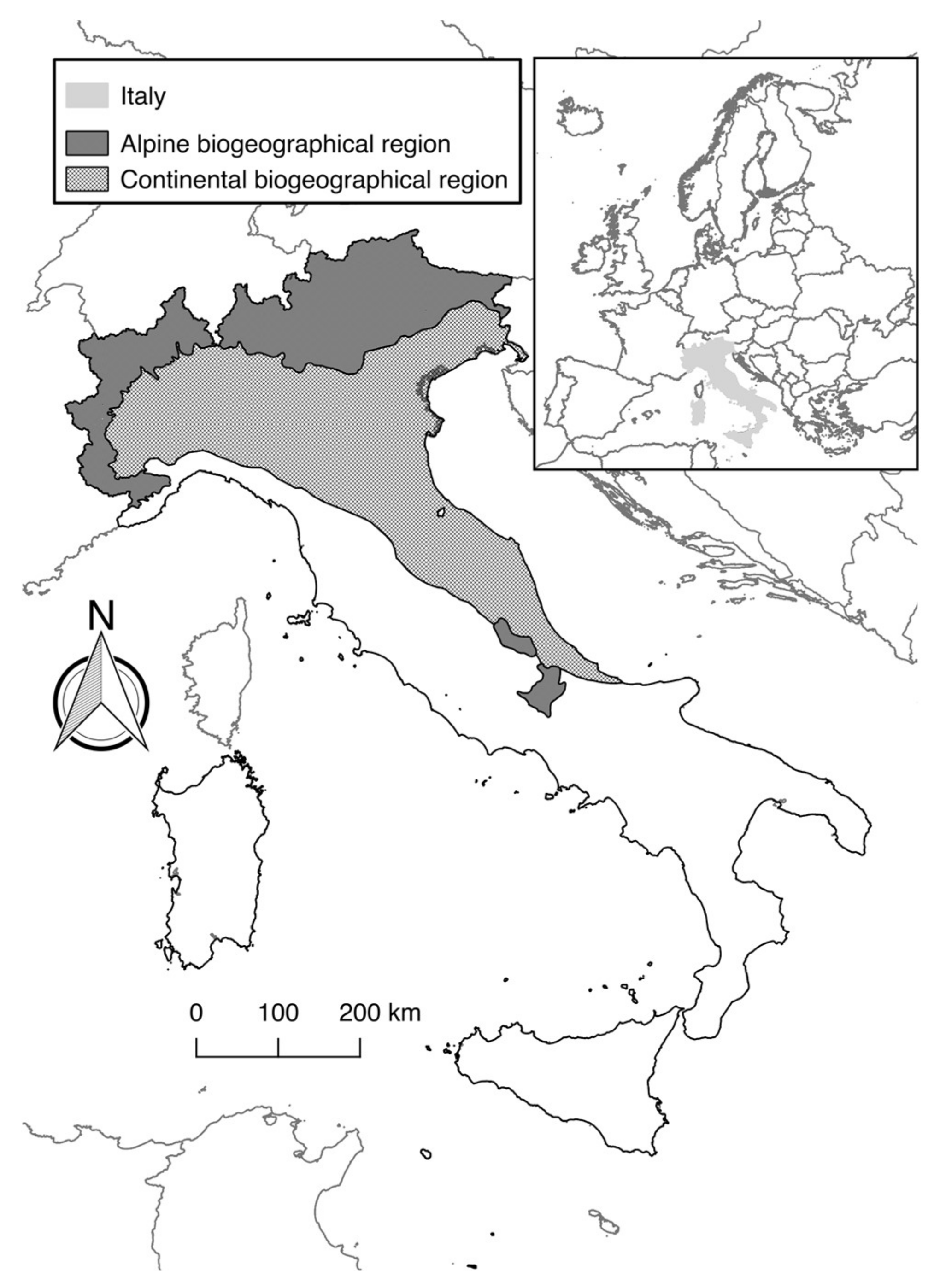
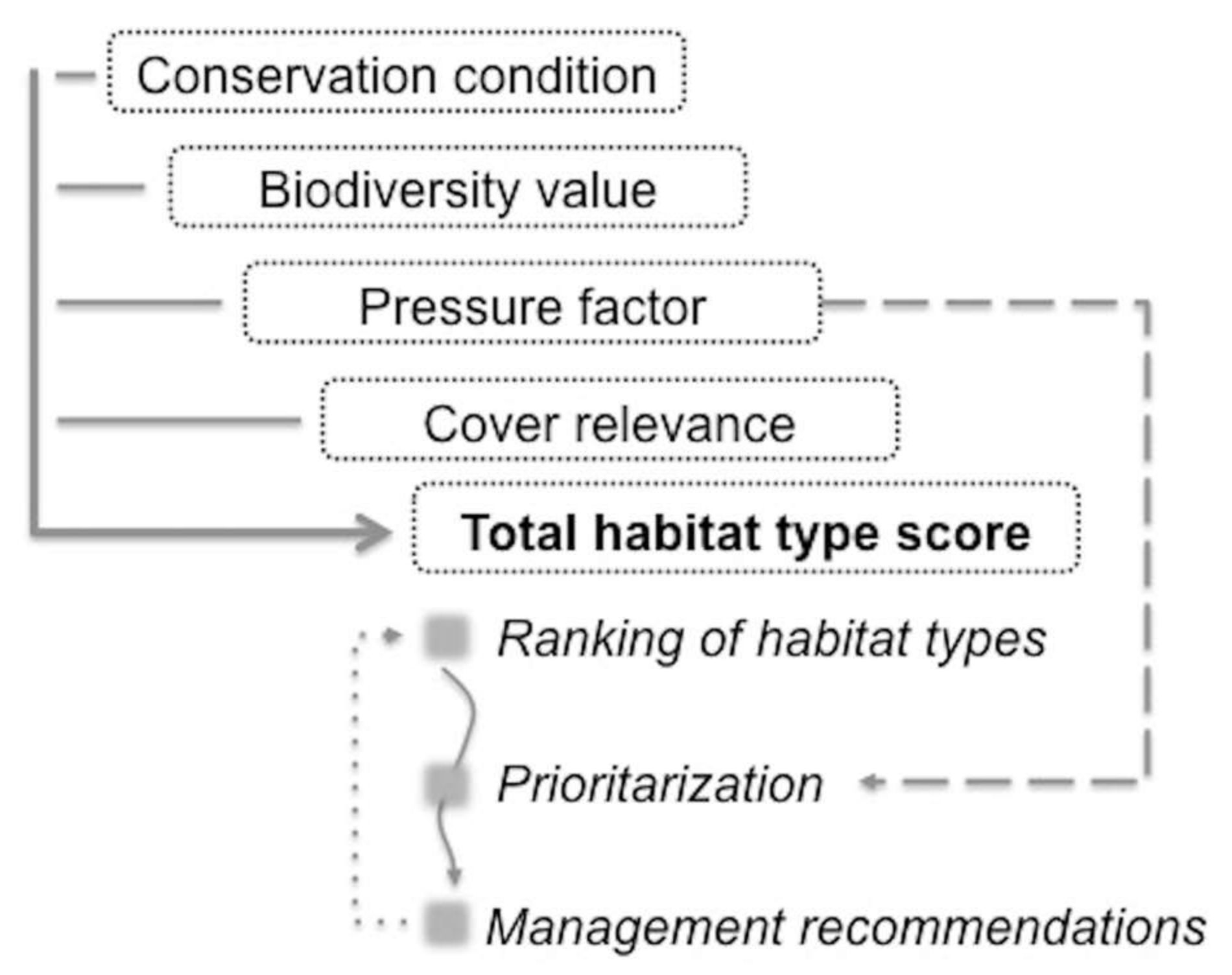
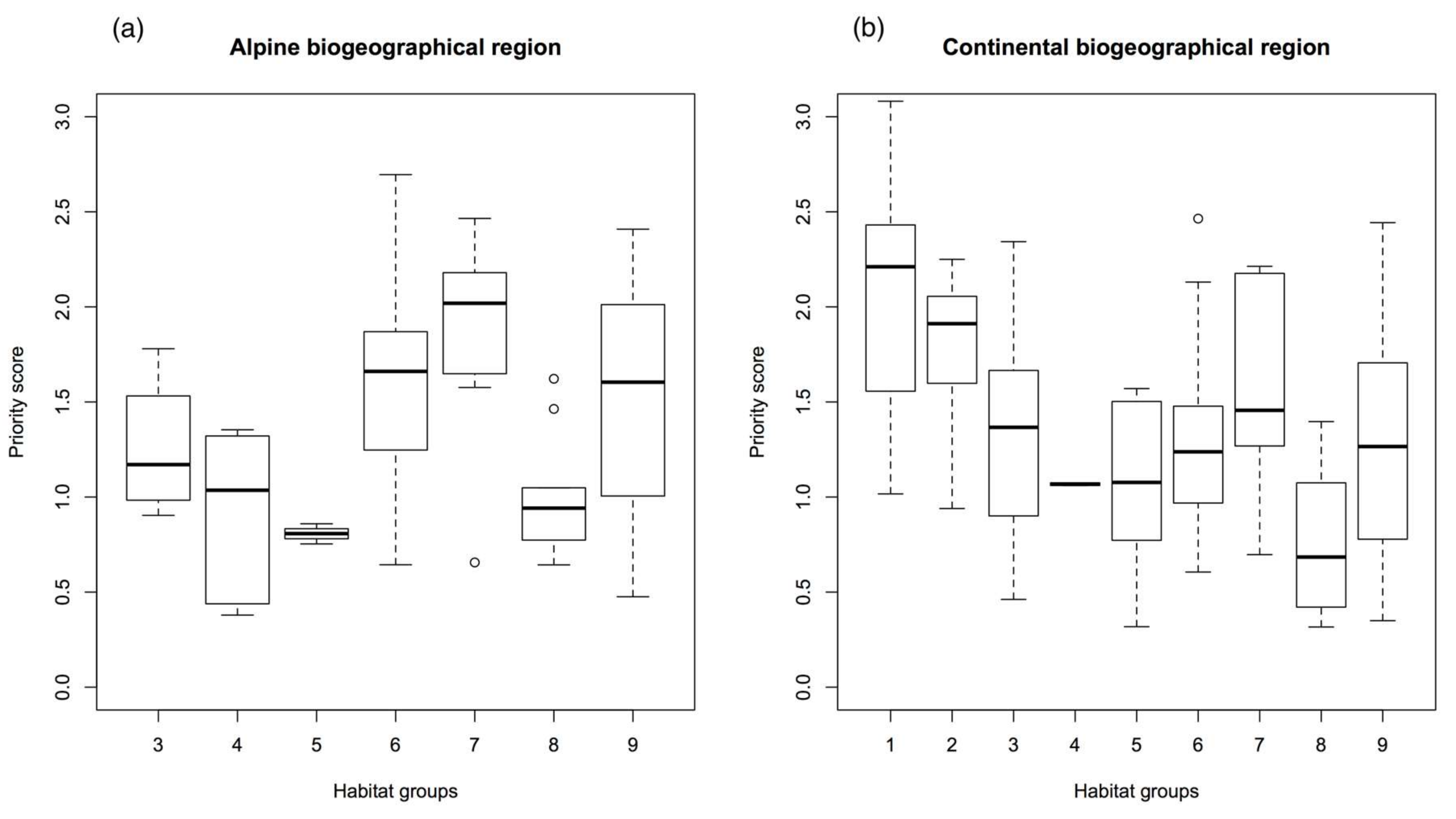
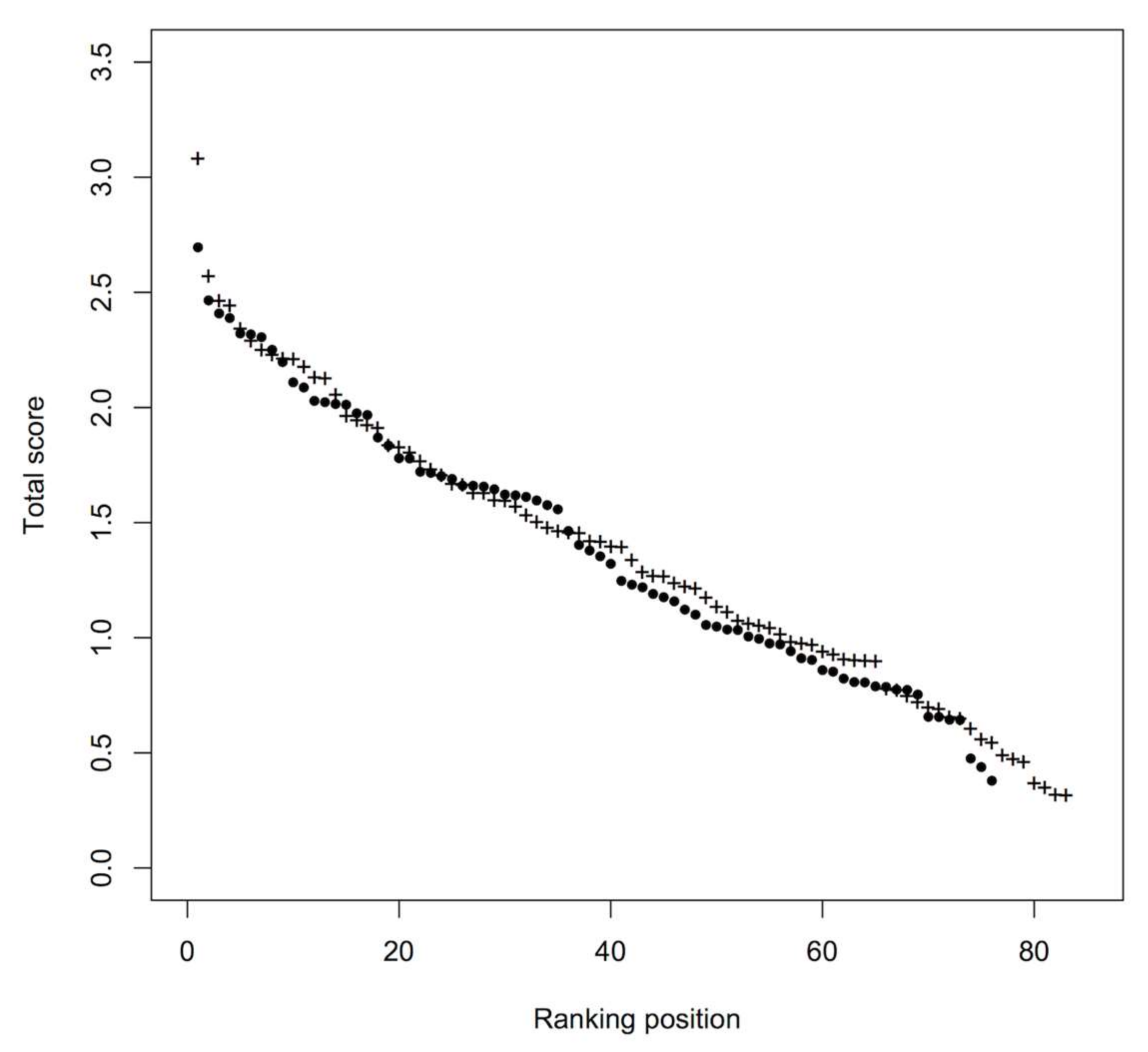
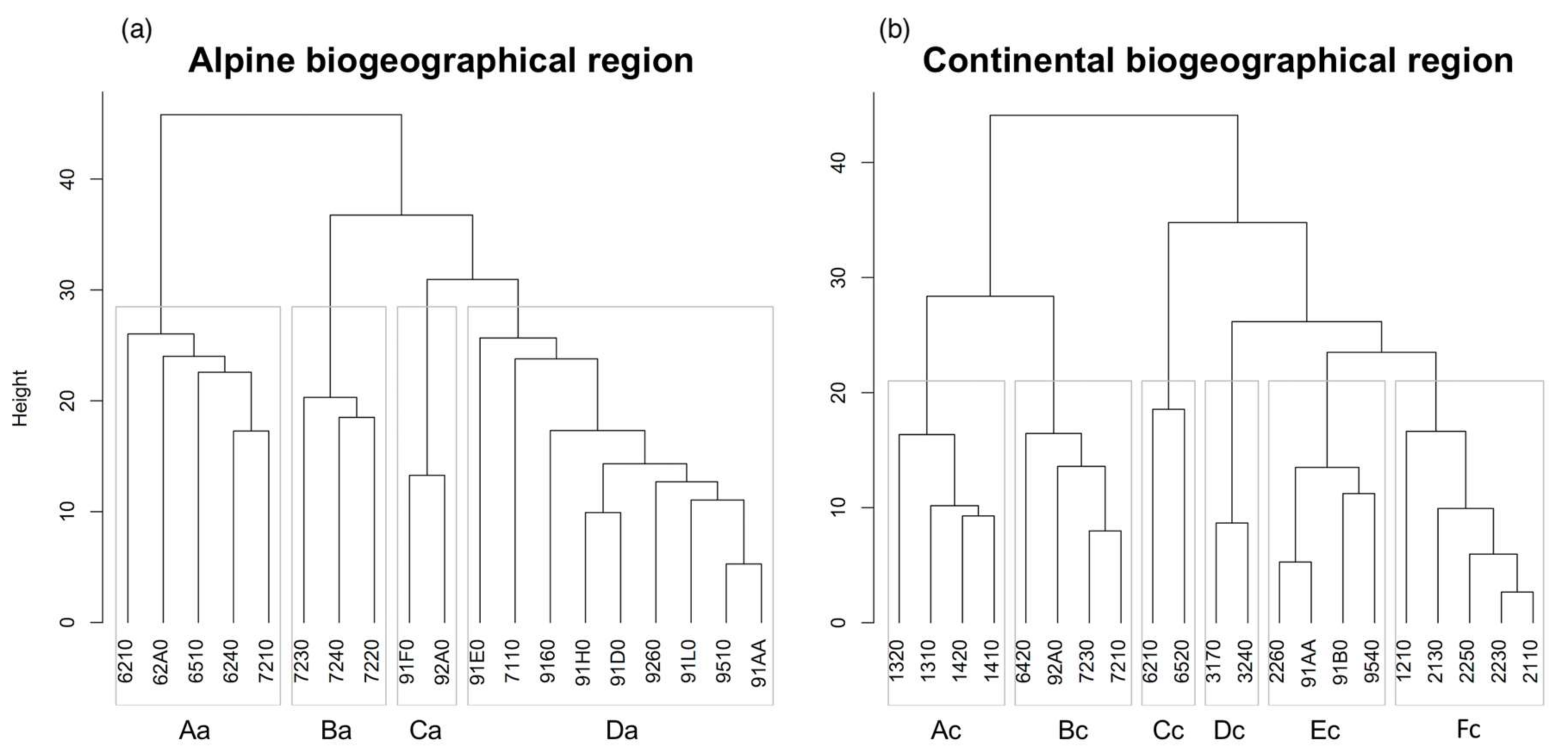
| Criteria | Parameters | Values | Scores | Possible Range before Rescaling | Studies Adopting Similar Criteria or Parameters | Equation | |
|---|---|---|---|---|---|---|---|
| Alpine | Continental | ||||||
| Conservation condition | Range (R) | Favorable | 0 | 0–4 | 0–4 | [25,35,37] | 1 CCi = Ri + Ai + Si + Fi, (1) |
| Area (A) | Unknown | 0.33 | |||||
| Structure and functions (S) | Inadequate | 0.66 | |||||
| Future prospects (F) | Bad | 1 | |||||
| Biodiversity value | Priority (P) | No | 0 | 0–∞ | 0–∞ | [28,35,50,51] | 2 CVi = Pi + ∑HDij + ∑Rlij + ∑Eij, (2) |
| Yes | 1 | ||||||
| Species of the Habitats Directive Annexes (HD) | Annex V | 0.25 | |||||
| Annex IV | 0.5 | ||||||
| Annex II | 0.75 | ||||||
| Priority Annex II | 1 | ||||||
| Red list species (Rl) | Least Concern | 0.1 | |||||
| Near Threatened | 0.2 | ||||||
| Vulnerable | 0.3 | ||||||
| Endangered | 0.4 | ||||||
| Critically Endangered | 0.5 | ||||||
| Endemic species (E) | No | 0 | |||||
| Yes | 0.5 | ||||||
| Pressure factor | Pressures (p) Threats (t) | Low | 0.33 | 0–∞ | 0–∞ | [33,52] | 3 PFi = ∑p(Ppi) + ∑t(Tti), (3) |
| Medium | 0.66 | ||||||
| High | 1 | ||||||
| Cover relevance | Cover relevance (CR) | Area proportion | 0-1 | 0–1 | 0–1 | [25,30,53,54] | 4 CRi = ACi/ATi, (4) |
| Rank | Habitat Type Code | Habitat Type Name | Priority Score |
|---|---|---|---|
| 1 | 6240 | * Sub-Pannonic steppic grasslands | 2.70 |
| 2 | 7230 | Alkaline fens | 2.47 |
| 3 | 91H0 | * Pannonian woods with Quercus pubescens | 2.41 |
| 4 | 62A0 | Eastern sub-Mediterranean dry grasslands (Scorzoneratalia villosae) | 2.39 |
| 5 | 91F0 | Riparian mixed forests of Quercus robur, Ulmus laevis and Ulmus minor, Fraxinus excelsior or Fraxinus angustifolia, along the great rivers (Ulmenion minoris) | 2.32 |
| 6 | 91E0 | * Alluvial forests with Alnus glutinosa and Fraxinus excelsior (Alno-Padion, Alnion incanae, Salicion albae) | 2.32 |
| 7 | 6210 | Semi-natural dry grasslands and scrubland facies on calcareous substrates (Festuco-Brometalia) (* important orchid sites) | 2.31 |
| 8 | 7110 | * Active raised bogs | 2.25 |
| 9 | 91L0 | Illyrian oak-hornbeam forests (Erythronio-Carpinion) | 2.20 |
| 10 | 7240 | * Alpine pioneer formations of Caricion bicoloris-atrofuscae | 2.11 |
| 11 | 92A0 | Salix alba and Populus alba galleries | 2.09 |
| 12 | 9160 | Sub-Atlantic and medio-European oak or oak-hornbeam forests of the Carpinion betuli | 2.03 |
| 13 | 7220 | * Petrifying springs with tufa formation (Cratoneurion) | 2.02 |
| 14 | 7210 | * Calcareous fens with Cladium mariscus and species of the Caricion davallianae | 2.02 |
| 15 | 9260 | Castanea sativa woods | 2.01 |
| 16 | 9510 | * Southern Apennine Abies alba forests | 1.97 |
| 17 | 91AA | * Eastern white oak woods | 1.97 |
| 18 | 6510 | Lowland hay meadows (Alopecurus pratensis, Sanguisorba officinalis) | 1.87 |
| 19 | 91D0 | * Bog woodland | 1.83 |
| Rank | Habitat Type Code | Habitat Type Name | Priority Score |
|---|---|---|---|
| 1 | 1320 | Spartina swards (Spartinion maritimae) | 3.08 |
| 2 | 1310 | Salicornia and other annuals colonizing mud and sand | 2.57 |
| 3 | 6420 | Mediterranean tall humid grasslands of the Molinio-Holoschoenion | 2.46 |
| 4 | 91B0 | Thermophilous Fraxinus angustifolia woods | 2.44 |
| 5 | 3170 | * Mediterranean temporary ponds | 2.34 |
| 6 | 1420 | Mediterranean and thermo-Atlantic halophilous scrubs (Sarcocornetea fruticosi) | 2.29 |
| 7 | 2230 | Malcolmietalia dune grasslands | 2.25 |
| 8 | 92A0 | Salix alba and Populus alba galleries | 2.23 |
| 9 | 7230 | Alkaline fens | 2.21 |
| 10 | 1410 | Mediterranean salt meadows (Juncetalia maritimi) | 2.21 |
| 11 | 7210 | * Calcareous fens with Cladium mariscus and species of the Caricion davallianae | 2.18 |
| 12 | 6210 | Semi-natural dry grasslands and scrubland facies on calcareous substrates (Festuco-Brometalia) (* important orchid sites) | 2.13 |
| 13 | 2250 | * Coastal dunes with Juniperus spp. | 2.13 |
| 14 | 2260 | Cisto-Lavenduletalia dune sclerophyllous scrubs | 2.06 |
| 15 | 2110 | Embryonic shifting dunes | 1.96 |
| 16 | 9540 | Mediterranean pine forests with endemic Mesogean pines | 1.94 |
| 17 | 3240 | Alpine rivers and their ligneous vegetation with Salix elaeagnos | 1.92 |
| 18 | 2130 | * Fixed coastal dunes with herbaceous vegetation (“grey dunes”) | 1.91 |
| 19 | 6520 | Mountain hay meadows | 1.84 |
| 20 | 1210 | Annual vegetation of drift lines | 1.83 |
| 21 | 91AA | * Eastern white oak woods | 1.81 |
| Alpine Group | Continental Group | Pressure Factors | Definition | IndVal.g | p |
|---|---|---|---|---|---|
| Cc | A02 | Modification of cultivation practices | 1 | 0.01 ** | |
| Aa | A02.01 | Agricultural intensification | 0.894 | 0.015 * | |
| Cc | A04.03 | Abandonment of pastoral systems, lack of grazing | 1 | 0.01 ** | |
| Fc | A07 | Use of biocides, hormones and chemicals | 0.846 | 0.026 * | |
| Aa | A08 | Fertilization | 0.866 | 0.01 ** | |
| Bc + Fc | A08 | Fertilization | 0.816 | 0.044 * | |
| Ca + Da | B02 | Forest and plantation management & use | 0.853 | 0.018 * | |
| Ca + Da | B07 | Other forestry activities | 1 | 0.001 *** | |
| Cc | C01 | Mining and quarrying | 1 | 0.01 ** | |
| Bc + Cc + Dc + Ec | D01.02 | Roads, motorways | 0.894 | 0.013 * | |
| Ba + Ca | D05 | Improved access to site | 0.852 | 0.035 * | |
| Ac + Bc + Cc + Dc | E01 | Urbanization and human habitation | 0.931 | 0.004 ** | |
| Aa + Ca + Da | G01 | Outdoor sports, leisure, and recreational activities | 0.901 | 0.033 * | |
| Cc + Ec | G01.03 | motorized vehicles | 0.816 | 0.05 * | |
| Ca | G05 | Other human intrusions and disturbances | 0.802 | 0.025 * | |
| Dc | G05.01 | Trampling, overuse | 0.91 | 0.002 ** | |
| Ac + Bc + Fc | H01 | Pollution to surface waters | 0.866 | 0.036 * | |
| Ca | I01 | Invasive alien species | 0.959 | 0.003 ** | |
| Ca | J02 | Changes in water bodies conditions | 0.934 | 0.003 ** | |
| Fc | J.02.01.03 | Infilling of ditches, dykes, ponds, pools, marshes, or pits | 0.943 | 0.021 * | |
| Ac | J.02.02.02 | Estuarine and coastal dredging | 1 | 0.002 ** | |
| Ac + Bc | J02.03.02 | Canalization | 0.935 | 0.002 ** | |
| Cc + Fc | J02.05 | Modification of hydrographic functioning, general | 0.866 | 0.036 * | |
| Ba | J02.06 | Water abstractions from surface waters | 0.816 | 0.024 * | |
| Ac + Bc | J02.07 | Water abstractions from groundwater | 1 | 0.001 *** | |
| Ca | J03 | Other changes to ecosystems | 0.926 | 0.003 ** | |
| Aa + Ca | K02 | Vegetation succession/Biocenotic evolution | 0.851 | 0.039 * | |
| Cc | K04.05 | Damage by herbivores (including game species) | 1 | 0.01 ** | |
| Ca | L08 | Flooding (natural processes) | 0.878 | 0.017 * |
© 2018 by the authors. Licensee MDPI, Basel, Switzerland. This article is an open access article distributed under the terms and conditions of the Creative Commons Attribution (CC BY) license (http://creativecommons.org/licenses/by/4.0/).
Share and Cite
Campagnaro, T.; Trentanovi, G.; Sitzia, T. Identifying Habitat Type Conservation Priorities under the Habitats Directive: Application to Two Italian Biogeographical Regions. Sustainability 2018, 10, 1189. https://doi.org/10.3390/su10041189
Campagnaro T, Trentanovi G, Sitzia T. Identifying Habitat Type Conservation Priorities under the Habitats Directive: Application to Two Italian Biogeographical Regions. Sustainability. 2018; 10(4):1189. https://doi.org/10.3390/su10041189
Chicago/Turabian StyleCampagnaro, Thomas, Giovanni Trentanovi, and Tommaso Sitzia. 2018. "Identifying Habitat Type Conservation Priorities under the Habitats Directive: Application to Two Italian Biogeographical Regions" Sustainability 10, no. 4: 1189. https://doi.org/10.3390/su10041189
APA StyleCampagnaro, T., Trentanovi, G., & Sitzia, T. (2018). Identifying Habitat Type Conservation Priorities under the Habitats Directive: Application to Two Italian Biogeographical Regions. Sustainability, 10(4), 1189. https://doi.org/10.3390/su10041189







